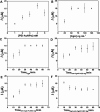Electrochemical Signal-Off Competitive Immunoassay of Chromogranin A toward a Sandwiched Graphene Oxide Structure for Neuroendocrine Tumor Detection
- PMID: 40556876
- PMCID: PMC12183582
- DOI: 10.1021/acsmeasuresciau.5c00048
Electrochemical Signal-Off Competitive Immunoassay of Chromogranin A toward a Sandwiched Graphene Oxide Structure for Neuroendocrine Tumor Detection
Abstract
Neuroendocrine tumors (NETs), often misdiagnosed and mistreated, require early detection for precise therapeutic interventions. This study presents a newly developed competitive electrochemical immunosensor for sensitive and selective detection of chromogranin A (CgA), a key biomarker for diagnosing and monitoring NETs. The sensor, featuring a sandwiched structure with versatile and multifunctional graphene oxide (GO), utilizes polyethylenimine-capped gold nanoparticles (PEI-AuNPs) to enhance the electroreactivity and biocompatibility of a screen-printed electrode (SPE). The immunosensor operates by immobilizing standard CgA antigens on the PEI-AuNPs/GO-modified SPE surface and employing GO nanotags loaded with anti-CgA antibodies (Ab) and ferrocene monocarboxylic acid (Fc) redox probes to capture target CgA. As the CgA concentration increases, the current response of the immunosensor decreases due to a reduction in the amount of Fc/Ab/GO tags on the electrode surface. This reduction occurs because the nanotags bind to the free CgA in the sample rather than the CgA immobilized on the electrode. The immunosensor demonstrates a good linearity (0.10-50 ng mL-1), a low detection limit of 90 pg mL-1, and high accuracy in detecting CgA levels in human serum samples. With its high specificity, long-term stability, and excellent reproducibility, our cost-effective and user-friendly platform holds promise for clinical screening and point-of-care diagnosis of NETs. Further optimization of the immunosensor's design and exploration of its use for additional biomarkers could enhance NETs' diagnosis and provide advancements in managing other related health conditions.
Keywords: chromogranin A; competitive assay; electrochemical immunosensor; neuroendocrine tumor; sandwich graphene oxide architecture.
© 2025 The Authors. Published by American Chemical Society.
Figures





Similar articles
-
Copper-enhanced electrochemical immunosensor based on gold nanoparticles for the quality control of hepatitis A virus vaccines.Talanta. 2025 Jul 12;297(Pt A):128579. doi: 10.1016/j.talanta.2025.128579. Online ahead of print. Talanta. 2025. PMID: 40669328
-
Dual-Mode Electrochemical Biosensor Based on Gold Nanoparticles/Two-Dimensional MoWS2/Graphene Oxide Composite for Detection of Glycated Albumin and Glucose toward Advancing Diabetes Diagnosis.ACS Appl Bio Mater. 2025 Jun 16;8(6):5215-5228. doi: 10.1021/acsabm.5c00534. Epub 2025 May 30. ACS Appl Bio Mater. 2025. PMID: 40443292 Free PMC article.
-
A label-free electrochemical immunosensor on gold-printed electrode for the electrochemical detection of C-reactive protein from blood samples.Mikrochim Acta. 2025 Jun 20;192(7):437. doi: 10.1007/s00604-025-07252-4. Mikrochim Acta. 2025. PMID: 40542313 Free PMC article.
-
Rethinking chromogranin A: unveiling gastrointestinal factors beyond neuroendocrine neoplasms-a narrative review.Transl Gastroenterol Hepatol. 2025 May 29;10:57. doi: 10.21037/tgh-24-113. eCollection 2025. Transl Gastroenterol Hepatol. 2025. PMID: 40755718 Free PMC article. Review.
-
Signs and symptoms to determine if a patient presenting in primary care or hospital outpatient settings has COVID-19.Cochrane Database Syst Rev. 2022 May 20;5(5):CD013665. doi: 10.1002/14651858.CD013665.pub3. Cochrane Database Syst Rev. 2022. PMID: 35593186 Free PMC article.
References
-
- Eads J. R., Reidy-Lagunes D., Soares H. P., Chan J. A., Anthony L. B., Halfdanarson T. R., Naraev B. G., Boris G., Wolin E. M., Halperin D. M., Li D., Pommier R. F., Zacks J. S., Morse M. A., Metz D. C.. Differential diagnosis of diarrhea in patients with neuroendocrine tumors. Pancreas. 2020;49(9):1123–1130. doi: 10.1097/MPA.0000000000001658. - DOI - PubMed
LinkOut - more resources
Full Text Sources
Research Materials
